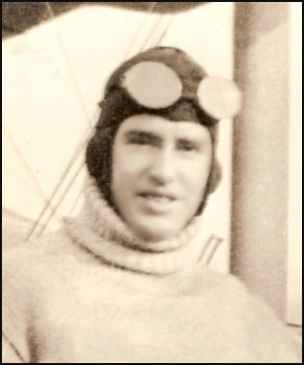
1890-1983 |
 |
by Bernard L. Whelan (Around May, 1913) Courtesy of Mary Anne Whelan |
|
I was still working at "Thomas" when my father gave me his check for $250.00 to start flight
training at Simms Station. Incidentally I still have that cancelled check along with the signed training agreement. The initial payment
covered only a little more than 4 hours air time training. I soloed within that amount of air time but subsequently spent an equivalent
amount for additional dual instruction and some solo flying. After signing up at The Wright Company, I told Harry Matthews, brother of
the President and principal owner of Thomas Manufacturing Company, what I was intending to do. He apparently told his brother and
while riding up to the office section on the elevator one morning, M.H. Matthews was also aboard. He mentioned that he heard I was
going to give up my job and take up flying. I said, "Yes, I want to learn to fly." He said, "Well, I think you are a damned fool." The Wright Company plant was as I recall on Coleman Street, on the west side of Dayton. The street names have been changed to some extent in that area but the two or three buildings that constituted the world's first production aircraft plant are still there and readily identifiable due to their distinctive front elevations. They were acquired and occupied by Inland Manufacturing Company, a division of General Motors a few years after WWI. Somewhere on them there should be a bronze tablet marking their historic significance. |
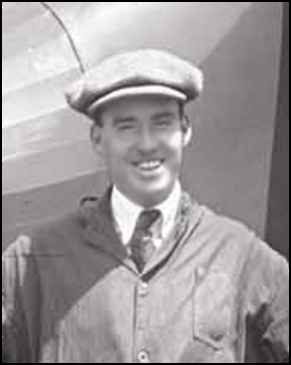 |
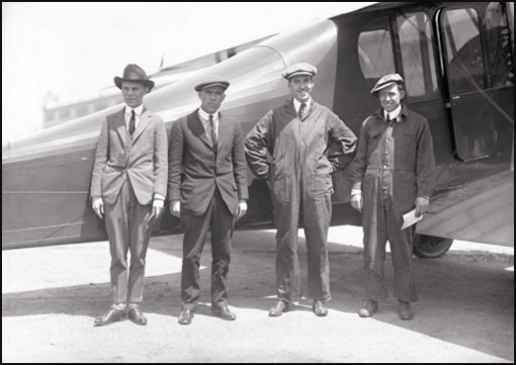 |
Left to right: Castro, Roy Zorn, Bernard Whelan & Roy "Tack" Lounsbury In front of the Dayton-Wright OW-1 Aerial Coupe just after setting a new altitude record with three passengers, 1920 Courtesy of Special Collections & Archives, Wright State University For the complete story, click on: Altitude Record |
by Bernard L. Whelan Courtesy of Mary Anne Whelan |
|
In 1915, Orville Wright, practically sole owner of the Wright Company, (Wilbur having died in 1912),
sold the patents and some of its physical assets to a company adopting the name of The Wright-Martin Company. He felt
overburdened in trying to operate the manufacturing side of the business in addition to pursuing the task of trying to collect the royalties
due under their original patents. The dishonest claims of Smithsonian Institute falsely trying to credit Prof. Langley, then head of
Smithsonian, with the invention of the airplane, posed another problem for Orville Wright. Dayton was a city of progressive industrialization, and there were certain men of prominence who wished to continue in the airplane business. E.A. Deeds and Charles F. Kettering owned a tract of land not far from downtown Dayton, called "McCook Field", named after one of the eaarly settlers of Dayton. There they started a flying school with Howard Rinehart as Chief Pilot and Archie Freeman, also Simms Station Trainee with F.A.I. (Federation Aeronautic International), license number 84, as his assistant. In downtown offices the design of a training plane was started. It was called Model F.S., standing for "First Shot". There were others in the organization, possibly Mr. H.E. Talbot, Sr., and his son Harold Talbot who later was elected President. Orville Wright agreed to act as the Company's consultant on all things aerodynamic. All this happened prior to this country entering WWI. McCook Field was sold or leased to the Signal Corps of the War Department and Dayton-Wright operated at what became known as South Field at Moraine, south of Dayton. Almost before one knew it we were in the war with "all four feet" and became a General motors unit; had accepted military orders for furnishing 400 J-1 standard training planes, 100 h.p. Hull Scott powered, and an unlimited number of British D.H.-4 light bomber and reconnaissance planes powered by the American built 410 h.p Liberty Power Plants. Having these important orders on their books Dayton-Wright required hangar facilities for certain design and manufacture of the two types. Colonel Deeds, one of the organizers of the newly formed company was called by the War Department to serve in an important procurement post and was prominently involved throughout the course of the war. Dayton-Wright |
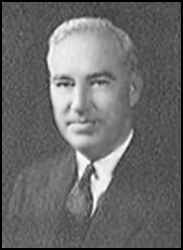 |
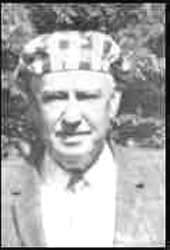 |
Collection of Mary Anne Whelan |
From the CHIRP |
|
In Dayton, Whelan became very interested in the intriguing early aviation developements of the Wright Brothers and watched their progress through those pioneering years. From the roof of a downtown office building Whelan saw Orville Wright make a flight from Simms Station to and over Dayton on September 22, 1910. He was so thrilled on this momentous occasion that he firmly resolved to learn to fly, but was not able to sell his father on the idea until the Spring of 1913. During the intervening time Whelan made the acquaintance of Wright Aviator J. Clifford Turpin (EB) who invited him to come out to the field and watch the flying. He accepted Turpin's invitation which naturally greatly increased his determination to make aviation his career. Whelan joined the early Spring class at the Wright School in May, 1913, and started training in June along with Maurice Priest, John Bixler, M. Schemmerhorn, Rod M. Wright, A. Bowersox and A. Bressman, and was taught to fly by instructor Oscar Brindley. He obtained is pilot license, No. 247, there on July 16, 1913, on a school Wright Model "B". After flying exhibitions for William Gabriel, he returned to Wright School in 1924 for additional instruction. In 1917 Whelan became a Signal Corps civilian flying instructor at Wilbur Wright Field, Dayton, Ohio and later at Ellington Field, Houston, Texas. The same year he joined Howard Rinehart (EB) on the staff of test pilots for the newly formed Dayton-Wright Company testing Liberty motored D. H. 4's. He remained with Dayton-Wright until it was dissolved about 1924. During this period and after World War I, Whelan assisted in the developement testing of a number of their new airplanes, did considerable instruction work and much cross-country flying, piloting Mr. C. F. Kettering and Col. E. A. Deeds and other company executives on business trips. OnMay 22, 1921, Whelan established a new altitude record of 19,710 feet at Dayton, Ohio, for commercial planes carrying pilot and three passengers, using the Dayton Wright "O. W." Aerial Coupe. The flight lasted 2 hours, 31 minutes. In 1923 he and Rinehart formed the Rinehart-Whelan Company to establish a business at the former Dayton-Wright Field at Moraine City, south of Dayton. They engaged in Passenger carrying, cross country trips, training, photography, and overhaul and sale of aircraft, engines and part. |
|
You will find an interesting mention of Bernard in the article about Ralph Charles, who is still flying at 100 years of age. You can visit that reference by clicking on: Bernard Whelan and using the "Find" function on "Whelan" I think you will enjoy this story. |
|
A Feature of Space Team Online. Email to Senator Glen from Mary Anne Whelan, M.D., 4-25,98 Dear Senator Glen, Learning of your forthcoming return to space - I could not resist adding to your mail, because it seems so extraordinary that only 30-some years separate the date of your birth from that of my father, Bernard L. Whelan, a pioneer aviator who learned to fly from the Wright Brothers in 1913. He held F.A.I. license #247 (I still have it) and had a long career in aviation, - a W.W. I flight instructor, subsequent test pilot for P&W (1930's) and finishing as a V.P. for United Aircraft. |
| I thought you might enjoy a picture of him in a Wright Model B - together with his instructor,
Oscar Brindley. (Brindley was killed testing O.W.'s for W.W. I - my father pulled him out of the wreck. I
think it was an even more hazardous profession in those days!) |
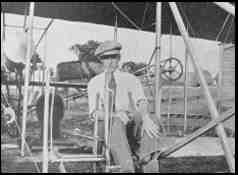 |
|
The best of luck on your forthcoming venture - Dad would have been most interested! Yours sincerely, Mary Anne Whelan, M.D. To visit The Challenge Project homepage, from which this email has been extracted by permission of Dr. Whelan, just click on: |
|
From The Early Birds of Aviation ROSTER, 1996 Back 

|